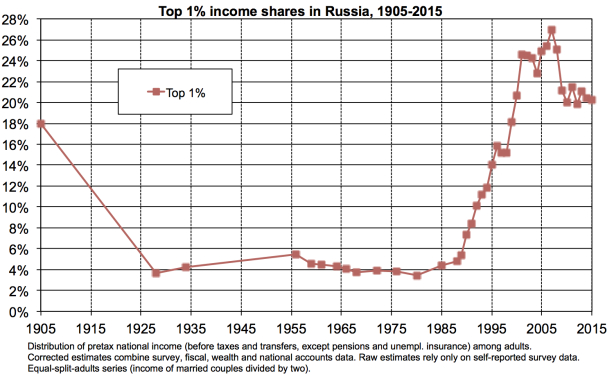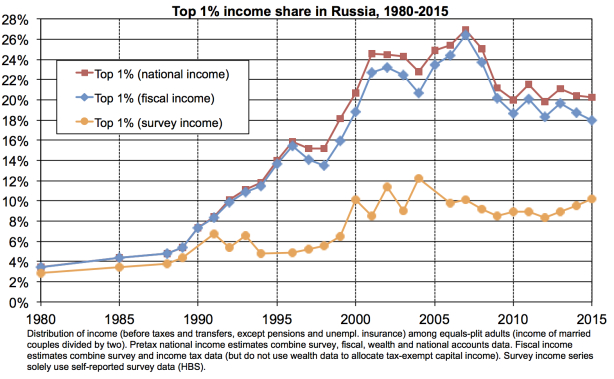From David Ruccio Russia is back in the news again in the United States, with the ongoing investigation of Russian interference in the U.S. presidential election as well as a growing set of links between a variety of figures (including Cabinet and family members) associated with Donald Trump and the regime of Vladimir Putin. This year is also the hundredth anniversary of the October Revolution, which sought to create the conditions for a transition to communism in the midst of a society characterized by various forms of feudalism, peasant communism, and capitalism. But we shouldn’t forget that, in addition, the Red Century has clearly left its mark on the political economy of the West, including the United States—both in the early years, when the “communist threat” undoubtedly led to
Topics:
David F. Ruccio considers the following as important: Uncategorized
This could be interesting, too:
tom writes The Ukraine war and Europe’s deepening march of folly
Stavros Mavroudeas writes CfP of Marxist Macroeconomic Modelling workgroup – 18th WAPE Forum, Istanbul August 6-8, 2025
Lars Pålsson Syll writes The pretence-of-knowledge syndrome
Dean Baker writes Crypto and Donald Trump’s strategic baseball card reserve
from David Ruccio
Russia is back in the news again in the United States, with the ongoing investigation of Russian interference in the U.S. presidential election as well as a growing set of links between a variety of figures (including Cabinet and family members) associated with Donald Trump and the regime of Vladimir Putin.
This year is also the hundredth anniversary of the October Revolution, which sought to create the conditions for a transition to communism in the midst of a society characterized by various forms of feudalism, peasant communism, and capitalism. But we shouldn’t forget that, in addition, the Red Century has clearly left its mark on the political economy of the West, including the United States—both in the early years, when the “communist threat” undoubtedly led to reforms associated with a more equal distribution of income, and later, when the Fall of the Wall reinforced the neoliberal turn to privatization and deregulation.
Now we have a third reason to think about Russia, which happens to intersect with the first two concerns. A new study of income and wealth data by Filip Novokmet, Thomas Piketty, Gabriel Zucman reveals just how much has changed in Russia from the time of the tsarist oligarchy through the Soviet Union to rise of the new oligarchy during and after the “shock therapy” that served to create a new form of private capitalism under Putin.
As is clear from the chart, income inequality was extremely high in Tsarist Russia, then dropped to very low levels during the Soviet period, and finally rose back to very high levels after the fall of the Soviet Union. Thus, for example, the top 1-percent income share was somewhat close to 20 percent in 1905, dropped to as little as 4-5 percent during the Soviet period, and rose spectacularly to 20-25 percent in recent decades.
The data sets used by Novokmet et al. reveal a level of inequality under the new oligarchs that is much higher that was the case using survey data—a top 1-percent income share that is more than double for 2007-08.
Novokmet et al. also show that the income shares of the top 10 percent and the bottom 50 percent moved in exactly opposite directions after the privatization of Russian state capitalism in the early 1990s. While the top 10-percent income share rose from less than 25 percent in 1990-1991 to more than 45 percent in 1996, the share of the bottom 50 percent collapsed, dropping from about 30 percent of total income in 1990-1991 to less than 10 percent in 1996, before gradually returning to 15 percent by 1998 and about 18 percent by 2015.
In comparison to other countries, Russia was much more equal during the Soviet period and, by 2015, had approached a level of inequality higher than that of France and comparable only to that of the United States.
Finally, Novokmet et al. have been able to estimate the enormous growth of private wealth under the new oligarchy, especially the wealth that was captured by a tiny group at the very top and is now owned by Russia’s billionaires. As the authors explain,
The number of Russian billionaires—as registered in international rankings such as the Forbes list—is extremely high by international standards. According to Forbes, total billionaire wealth was very small in Russia in the 1990s, increased enormously in the early 2000s, and stabilized around 25-40% of national income between 2005 and 2015 (with large variations due to the international crisis and the sharp fall of the Russian stock market after 2008). This is much larger than the corresponding numbers in Western countries: Total billionaire wealth represents between 5% and 15% of national income in the United States, Germany and France in 2005-2015 according to Forbes, despite the fact that average income and average wealth are much higher than in Russia. This clearly suggests that wealth concentration at the very top is significantly higher in Russia than in other countries.
Clearly, there is nothing “natural” about the distribution of income and the ownership of wealth. This new study demonstrates that different economic structures and political events create fundamentally different levels of inequality in both income and wealth, both within and between countries.
The Russian experience is a perfect example how inequality can fall and then, later, be reversed with radical economic and political transformations—thus creating a new oligarchy that dominates the national political economy and seeks to intervene in other countries.
Not unlike the United States.





